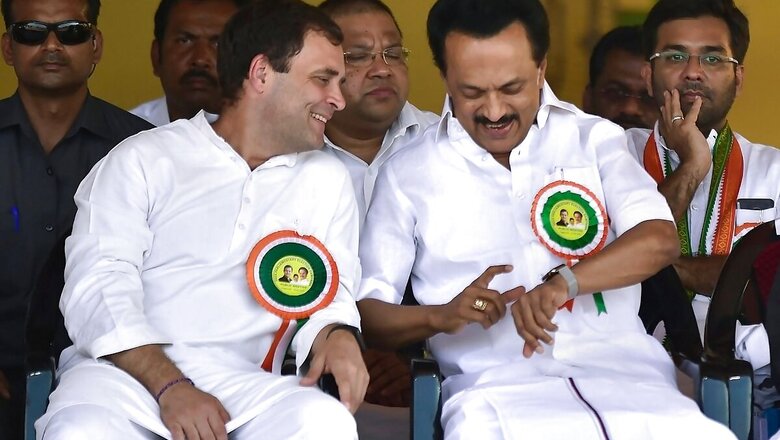
views
The Justice Party, the forerunner to the Dravidar Kazhagam, the parent organization of the Kazhagams in Tamil Nadu, emerged in the 1920s as a separatist force, which apart from seeking social justice for the backward classes and scheduled castes, was essentially anti-North, anti-Hindi, anti-Centre. Today, the self-proclaimed inheritors of the Dravidar Kazhagam have unabashedly hugged national parties like the BJP and the Congress, forged electoral alliances and shared power with them at the Centre. The political landscape of the state has therefore changed.
The Dravidar Kazhagam (DK) and its offspring, the Dravida Munnetra Kazhagam, were committed to forming a separate Dravida country. DK founder E.V. Ramasamy (also known as Periyar) was shocked when the British did not accede to the DK’s demand for a separate Dravida nation even as Pakistan was created. Periyar, claim historians, had earlier been assured by Jinnah and the British that Dravidastan (Dravida Nadu) would come into being. The British turned down the DK demand in 1947, while Jinnah said he could not help the DK at that stage.
The scars of these events stayed with Periyar who, on the eve of Independence Day (August 15, 1947) shaken by the reluctance of the British to create a Dravida Nadu, gave a call to observe the day as one of sorrow and mourning.
Periyar vs Annadurai
However, by this time, the differences between Periyar and C.N. Annadurai, the Dravidar Kazhagam’s general secretary, were out in the open. Annadurai publicly repudiated Periyar, by stating that “Independence Day should be celebrated without any reservation. … We have made it very clear that our opposition to the Congress should not be misconstrued as our opposition to freedom.”
Annadurai, in an editorial in his weekly Dravida Nadu, wrote, “We have been very consistent in our demand that the Britishers should leave our soil without any further delay so that we may look after our own affairs. …it would be suicidal not to participate in the celebration of the most glorious day in Indian history but consider it a day of mourning”.
Touching upon the sacrifices of freedom fighters in the state, Anna said, “On this day, we must bow in reverence to their memory. August 15 is a memorable day of fulfillment of their dreams. To consider this day as a day of mourning would be nothing short of doing great injustice to their memory and that would not be in keeping with the high traditions of the Tamil people,” he said in a critical reference aimed at Periyar.
“This is an occasion for us to prove that we are not an agent of the British Raj; and any thoughtless and hasty step we take by dissociating ourselves from the celebration of this great event would only give a handle to our opponents to stigmatise permanently that we are a fifth column of a foreign power working against national interest,” Anna wrote, invoking the wrath of Periyar supporters.
Periyar and Annadurai drifted further apart even as a section of the Dravidar Kazhagam workers hoisted black flags on August 15. The second flashpoint came when Periyar married Maniammai (32), his personal assistant, on July 10, 1949, rejecting the criticism by senior leaders of the DK. Several senior leaders like Annadurai broke away from the DK and formed the Dravida Munnetra Kazhagam on September 17, 1949.
The shift in 1962
Right through the 1950s, the DMK maintained that it stood for a separate Dravida Nadu, with Annadurai even making the demand in Parliament. In 1963, then Congress government, mainly with a view to check the DMK and its demand for separation, brought in an amendment to the Article 19 (2) of the Indian Constitution—the bill was popularly known as the ‘anti-secession bill’—to ensure political parties do not use the election process to propagate secession.
However, by the time the Indo-China war took place in 1962, Annadurai had already scaled down the secessionist demand. Since the 1962 Assembly election in the state, the DMK had slowly moved away from the secessionist agenda and instead looked to playing an important role at the Centre. With the split in the Congress in 1969, DMK MPs occupied an important position in then PM Indira Gandhi’s strategy.
The DMK, facing heat due to an alliance between Congress(O) led by K. Kamaraj in Tamil Nadu and C. Rajagopalachari’s Swatantra party, took the unusual step of aligning with the Congress (I) in 1971. This was the first time that a Dravidian party had electoral ties with the Congress.
Since then, Dravidian parties of various hues and shades have vied with one another to forge alliances with the Congress. MGR’s new party, the All India Anna Dravida Munnetra Kazhagam (AIADMK), had an alliance with the Congress in the 1977 Lok Sabha elections. It was the turn of the DMK to tie-up with the Congress in the 1980 Lok Sabha and state Assembly elections.
In 1984, it was MGR’s AIADMK which chose the Congress as its ally for the Lok Sabha and Assembly polls held simultaneously, and Jayalalithaa’s AIADMK followed suit in 1991, 1996 and 2001. The DMK sought the hand of the Congress in 2004, 2009, 2016, 2019—with the alliance continuing in the 2021 Assembly polls.
In 1979, the AIADMK, for the first time, secured two cabinet berths for its MPs—Bala Pajanor and Sathyavani Muthu in the Charan Singh-led government at the Centre. This set a new pattern, with both the DMK and AIADMK trying to be part of the Union cabinet, right from 1996.
In the upcoming Assembly election, the AIADMK has tied-up with one national party, the BJP, while the DMK has another national party, the Congress, as its partner. The wheel has moved a full circle for the Dravidian parties, which now seek to share power with the national parties at the Centre and rub shoulders with them during the state Assembly polls.
Read all the Latest News, Breaking News and Coronavirus News here. Follow us on Facebook, Twitter and Telegram.














Comments
0 comment